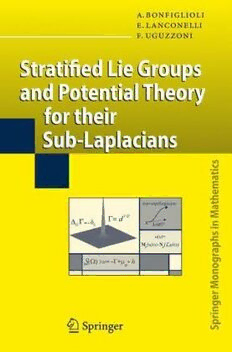Table Of ContentSpringer Monographs in Mathematics
A. Bonfiglioli • E. Lanconelli • F. Uguzzoni
Stratified Lie Groups
and Potential Theory
for their Sub-Laplacians
A.Bonfiglioli F.Uguzzoni
UniversitàBologna,Dip.toMatematica UniversitàBologna,Dip.toMatematica
PiazzadiPortaSanDonato5 PiazzadiPortaSanDonato5
40126Bologna,Italy 40126Bologna,Italy
e-mail:bonfi[email protected] e-mail:[email protected]
E.Lanconelli
UniversitàBologna,Dip.toMatematica
PiazzadiPortaSanDonato5
40126Bologna,Italy
e-mail:[email protected]
LibraryofCongressControlNumber:2007929114
MathematicsSubjectClassification(2000):43A80,35J70,35H20,35A08,31C05,31C15,
35B50,22E60
ISSN1439-7382
ISBN-103-540-71896-6 SpringerBerlinHeidelbergNewYork
ISBN-13978-3-540-71896-3 SpringerBerlinHeidelbergNewYork
Thisworkissubjecttocopyright.Allrightsarereserved,whetherthewholeorpartofthematerialisconcerned,specifically
therightsoftranslation,reprinting,reuseofillustrations,recitation,broadcasting,reproductiononmicrofilmorinanyother
way,andstorageindatabanks.Duplicationofthispublicationorpartsthereofispermittedonlyundertheprovisionsofthe
GermanCopyrightLawofSeptember9,1965,initscurrentversion,andpermissionforusemustalwaysbeobtainedfrom
Springer.ViolationsareliableforprosecutionundertheGermanCopyrightLaw.
SpringerisapartofSpringerScience+BusinessMedia
springer.com
(cid:2)c Springer-VerlagBerlinHeidelberg2007
Theuseofgeneraldescriptivenames,registerednames,trademarks,etc.inthispublicationdoesnotimply,eveninthe
absenceofaspecificstatement,thatsuchnamesareexemptfromtherelevantprotectivelawsandregulationsandtherefore
freeforgeneraluse.
TypesettingbytheauthorandVTEXusingaSpringerLATEXmacropackage
Coverdesign:WMXDesign,Heidelberg,Germany
Printedonacid-freepaper SPIN:12029525 VA41/3100/VTEX-543210
ToProfessorBrunoPini
andtoourFamilies
Preface
WiththisbookweaimtopresentanintroductiontothestratifiedLiegroupsandto
theirLiealgebrasoftheleft-invariantvectorfields,startingfrombasicandelemen-
tary facts from linear algebra and differential calculus for functions of several real
variables. The second aim of this book is to perform a potential theory analysis of
thesub-Laplacianoperators
(cid:2)m
L= X2,
j
j=1
where the X ’s are vector fields, i.e. linear first order partial differential operators,
j
generatingtheLiealgebraofastratifiedLiegroup.
In recent years, these operators have received considerable attention in litera-
ture, mainly due to their basic rôle in the theory of subelliptic second order partial
differentialequationswithsemidefinitecharacteristicform.
1. SomeHistoricalOverviews
Generalsecondorderpartialdifferentialequationswithnon-negativeanddegenerate
characteristicformhaveappearedinliteraturesincetheearly1900s.Theywerefirst
studiedbyM.Picone,whocalledthemelliptic-parabolicequationsandprovedthe
celebratedweakmaximumprinciplefortheirsolutions[Pic13,Pic27].
The interest in this type of equations in application fields was originally found
byA.D.Fokker,M.PlanckandA.N.Kolmogorov.Theydiscoveredthatpartialdif-
ferential equations with non-negative characteristic form arise in the mathematical
modelingoftheoreticalphysicsandofdiffusionprocesses[Fok14,Pla17,Kol34].
Since then, over the past half-century, this type of equations appeared in many
otherdifferentresearchfields,boththeoreticalandapplied,includinggeometricthe-
ory of several complex variables, Cauchy–Riemann geometry, partial differential
equations, calculus of variations, quasiconformal mappings, minimal surfaces and
convexity in sub-Riemannian settings, Brownian motion, kinetic theory of gases,
VIII Preface
mathematicalmodelsinfinanceandinhumanvision.Wereportashortlistofrefer-
encesforthesetopicsattheendofthispreface.
Afirstsystematicstudyofboundaryvalueproblemsforwideclassesofelliptic-
parabolicoperatorswasperformedbyG.Fichera.In1956[Fic56a,Fic56b],heproved
existencetheoremsofweaksolutionsofthe“Dirichletproblem”andfoundtheright
subsetoftheboundaryonwhichthedatahavetobeprescribed.
Some years later, several existence and regularity results for elliptic-parabolic
operators were proved by O.A. Ole˘ınik and E.V. Radkevicˇ and by J.J. Kohn and
L. Nirenberg (see the monograph [OR73] for a presentation and a wide survey on
this subject). The methods used by these authors required particular assumptions
ontheFicheraboundaryset andledtoregularityresultsstronglydependingonthe
regularityoftheboundarydata.
1.1.L.Hörmander’sTheorem
The investigations of the local regularity properties of the solutions to elliptic-
parabolic equations, that is, regularity properties only depending on the given op-
erator, have produced more interesting results. The most beautiful ones have been
obtainedforelliptic-parabolicequationswithunderlyingalgebraic-geometricstruc-
tures of sub-Riemanniantype.The milestone of these research fieldis a celebrated
theoremofL.Hörmanderprovedin1967.
Theorem1(L.Hörmander,[Hor67]). Let X ,...,X and Y be smooth vectors
1 m
fields,i.e.linearfirstorderpartialdifferentialoperatorswithsmoothcoefficientsin
theopensetΩ ⊆RN.Suppose
(cid:3) (cid:4)
rank Lie{X ,...,X ,Y}(x) =N ∀x ∈Ω. (P.1)
1 m
Thentheoperator
(cid:2)m
L= X2+Y (P.2)
j
j=1
is hypoelliptic in Ω, i.e. every distributional solution to Lu = f is of class C∞
∞
wheneverf isofclassC .
Condition (P.1) simply means that at any point of Ω one can find N linearly
independentdifferentialoperatorsamongX ,...,X ,Y andalltheircommutators
1 m
(theLiealgebrageneratedby{X ,...,X ,Y}).
1 m
Hörmander’s work opened up a research field, the most remarkable contribu-
tions to which have been given by G.B. Folland, L.P. Rothschild and E.M. Stein.
They developed and applied to (P.2) the singular integral theory in nilpotent Lie
groups.1
1Theapplicationofthistheoryalsooccursinthedevelopmentsstartedfromtheworksby
¯ ¯
J.J.Kohnonthe∂-Neumannproblemandthe∂bcomplex.
1. SomeHistoricalOverviews IX
By using these techniques, in 1975, G.B. Folland accomplished a functional
analytic study of sub-Laplacians on stratified Lie groups [Fol75]. One year later
L.P.RothschildandE.M.Steinprovedtheircelebratedliftingtheorem(see[RS76]),
enlighteningthebasicrôleplayedbythesub-Laplaciansinthetheoryofsecondor-
derpartialdifferentialequationswhicharesumofsquaresofvectorfields.Inforce
ofthistheorem,indeed,wecanroughlysaythat:
(cid:5)
Every operator L = m X2 satisfying the Hörmander rank condition
j=1 j
(cid:6)
(P.1) can be lifted to an operator L “as close as we want” to a sub-
Laplacian.
1.2.TheRankCondition
Thegeometricalmeaningoftherankcondition(P.1)isclarifiedbytheC.Carathéod-
ory,W.L.ChowandP.K.Rashevskytheorem:
If(P.1)issatisfied,thengiventwopointsx,y ∈Ω,sufficientlyclose,thereexists
apiecewisesmoothcurve,containedinΩ andconnectingx andy,whichisthesum
ofintegraltrajectoriesofthevectorfields±X ,...,±X ,±Y.
1 m
Theappearanceof(P.1)inHörmander’stheoremseemstobesuggestedbysome
deeppropertiesoftheKolomogorovoperators(seealsotheIntroductionin[Hor67]),
whichwenowaimtodiscuss.
In studying diffusion phenomena from a probabilistic point of view, A.N. Kol-
mogorovshowedthattheprobabilitydensityofasystemwith2ndegreesoffreedom
satisfiesanequationwithnon-negativecharacteristicform
Ku=0 inR2n×R,
where R2n is the phase-space of the system. A prototype for K is the following
operator
(cid:2)n (cid:2)n
K = ∂2 + x ∂ −∂ , (P.3)
xj j yj t
j=1 j=1
wherex = (x ,...,x )andy = (y ,...,y )denotethevelocityandtheposition
1 n 1 n
vectorsofthesystem,respectively.TheoperatorK is“verydegenerate”:itssecond
orderpartonlycontainsderivativeswithrespecttothevariablesx ,...,x .Never-
1 n
theless,asKolmogorovshowed,ithasafundamentalsolutionΓ whichissmoothout
of its pole.This impliesthatK is hypoelliptic,that is, every distributionalsolution
toKu=f isofclassC∞ wheneverf isofclassC∞.TheexplicitexpressionofΓ
isgivenby
(cid:3) (cid:4)
Γ(z,t;ζ,τ)=γ ζ −E(t −τ)z,t −τ , z=(x,y), ζ =(ξ,η), (P.4)
whereγ(z,t)=0ift ≤0,and
(cid:7) (cid:10)
(4π)n 1(cid:8) (cid:9)
γ(z,t)= √ exp − C−1z,z ift >0. (P.5)
detC(t) 4
X Preface
Here, (cid:9)·,·(cid:10) stands for the usual inner product in R2n; E(t) and C(t), respectively,
denotethe2n×2nmatrices
(cid:7) (cid:7) (cid:10)(cid:10) (cid:11)
0 0 t
E(t)=exp −t , C(t)= E(s)AE(s)T ds.
I 0
n 0
(cid:3) (cid:4)
Moreover, I denotes the identity matrix of order n and A = In 0 . We explicitly
n 0 0
remarkthat
C(t)>0 foreveryt >0. (P.6)
Thisconditionmakesexpression(P.5)meaningfulandcanberestatedingeometrical–
differentialterms.Indeed,denoting
(cid:5)
X =∂ and Y = n x ∂ −∂ ,
j xj k=1 k yk t
itcanbeprovedthat(P.6)isequivalenttothefollowingrankcondition:
(cid:3) (cid:4)
rank Lie{X ,...,X ,Y}(z,t) =2n+1 ∀(z,t)∈R2n+1. (P.7)
1 n
ItisalsoworthwhiletonotethattheKolmogorovoperatorK canbewrittenas
(cid:2)n
K = X2+Y. (P.8)
j
j=1
1.3.TheLeftTranslationandDilationInvariance
Thestructure(P.4)ofKolmogorov’sfundamentalsolutionsuggeststherelevancethat
aLiegrouptheoreticalapproachhasintheanalysisofHörmanderoperators.Indeed,
fromtheexplicitexpressionofΓ onerealizesthat
(cid:3) (cid:4)
Γ(z,t;ζ,τ)=γ (ζ,τ)−1◦(z,t) ,
where ◦ is the following composition law making K := (R2n × R,◦) a non-
commutativeLiegroup
(cid:3) (cid:4)
(z,t)◦(z(cid:12),t(cid:12)):= z(cid:12)+E(t(cid:12))z,t +t(cid:12) ,
i.e.moreexplicitly,
(cid:3) (cid:4)
(x,y,t)◦(x(cid:12),y(cid:12),t(cid:12))= x+x(cid:12),y+y(cid:12)+t(cid:12)x,t +t(cid:12) .
In K one has (ζ,τ)−1 = (−E(−t)ξ,−τ). It is easy to check that K is invariant
w.r.t.thelefttranslationsonKandcommuteswiththefollowingdilations:
d (z,t):=(λx,λ3y,λ2t), λ>0.
λ
Foreveryλ>0,d isanautomorphismofK,sothat(R2n×R,◦,d )isahomoge-
λ λ
neousLiegroup.Itcanbe(cid:5)seenthatitsLiealgebraistheonegeneratedbythevector
fieldsX =∂ andY = n x ∂ −∂ appearingin(P.8).
j xj k=1 k yk t
1. SomeHistoricalOverviews XI
1.4.TheEllipticCounterpart:StratifiedGroupsandSub-Laplacians
Forapropercomprehensionandappreciationofthistypeof“parabolic”-typeopera-
torssuchastheaboveKolmogorovoperatorK,itiscrucialtopossessadeepknowl-
edgeoftheir“elliptic”counterpart.Thisseemsunavoidable,alsobearinginmindthat
theunderlyingalgebraic–geometricstructuresofthesetwodifferentclassesofoper-
ators are almost identical. Let us go back again, for a mom(cid:5)ent, to the Kolmogorov
operator (P.3). If in that operator we square the term Y = n x ∂ −∂ , we
j=1 j xj+n t
obtainthefollowing“sumofsquare”-operator(whichwemayrefertoasthe“elliptic
counterpart”ofK):
(cid:12) (cid:13)
(cid:2)n (cid:2)n 2
L:= ∂2 + x ∂ −∂ . (P.9)
xj j xj+n t
j=1 j=1
ThecharacteristicformofLisanon-negativequadraticformwithnon-trivialkernel.
ThenLhastobeconsideredasadegenerateellipticoperator.However,itishypoel-
liptic: the Hörmander rank condition (P.7) does not distinguish between L and K!
Moreover,Lisleft-invarianton(R2n ×R,◦)(aswealreadyknow,soarethe∂ ’s
xj
andY)but,thistime,itcommuteswiththedilations
δ (z,t)=(λx,λ2y,λ2t), λ>0.
λ
Alsothesedilationsareautomorphismsof(R2n×R,◦),andG:=(R2n×R,◦,δ )
λ
becomes a stratified Lie group whose generators are the vector fields ∂ ’s and Y.
xj
Then,accordingtoourgeneralagreement,Lisasub-Laplacian2onG.
1.5.TheHeisenbergGroup
Inthelower-dimensionalcasen=1,theoperator(P.9)is
∂2+(x∂ −∂ )2, (x,y,t)∈R3. (P.10)
x y t
Uptoachangeandarelabelingofthevariables,thiscanbewrittenasfollows:
(∂2+2y∂ )2+(∂ −2x∂ )2, (x,y,t)∈R3,
x t y t
which,inturn,isthelower-dimensionalversionofthecelebratedsub-Laplacianon
theHeisenberggroup.
TheHeisenberggroupHn isthestratifiedLiegroup(R2n+1,◦)whosecomposi-
tionlawisgivenby
(cid:3) (cid:4)
(z,t)◦(z(cid:12),t(cid:12))= z+z(cid:12),t +t +2Im(cid:9)z,z(cid:12)(cid:10) . (P.11)
HereweidentifyR2n withCn,andweusethenotation
2AllthesenotionswillbeproperlyintroducedinChapter1.

